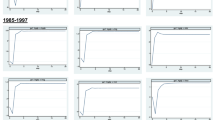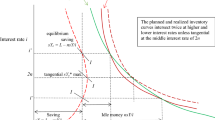Abstract
Alberto Alesina’s empirical work has led to re-examination of Keynesian theory and policy. His demonstration that reductions in public spending are often followed by improvements in economic conditions is a direct contradiction of modern macroeconomic theory, where increases in aggregate demand are seen as the most important precondition for recovery even where such increases in demand are unproductive in themselves and largely wasteful. The present paper suggests that the theoretical framework necessary to understand Alesina’s empirical results is embedded within the classical theory of the cycle which argues that only value adding production could lead to recovery. Most importantly, the paper argues that only through a correct understanding of Say’s Law of markets can Alesina’s empirical results be properly understood.
Similar content being viewed by others
Notes
Question addressed by Senator Doug Cameron to Dr. Steven Kates during Senate Economics References Committee Hearing, 21 September 2009, page E14.
The advice I had been trying to convey can be seen in the following passage from an article of mine published in the Australian political monthly, Quadrant, in March 2009:
“Just as the causes of this downturn cannot be charted through a Keynesian demand-deficiency model neither can the solution. The world’s economies are not suffering from a lack of demand and the right policy response is not a demand stimulus. Increased public sector spending will only add to the market confusions that already exist.
“What is potentially catastrophic would be to try to spend our way to recovery. The recession that will follow will be deep, prolonged and potentially take years to overcome.” (Kates 2009: 9)
It ought to be a puzzle how the phrase “Say’s Law” came to be used by Keynes, but in typical Keynesian fashion the issue is avoided, because even to ask how Keynes came to use this term would raise many questions Keynesians would prefer left alone. For example, what was Keynes reading as part of his background research that no one has yet identified and which he kept to himself and so far as we know shared with no one. See Kates 2010 for a comprehensive discussion of Keynes’s unknown research agenda undertaken during 1933 and 1934, years of which there is virtually no discussion about the road between The Treatise on Money and The General Theory.
This was the eighth edition. The first seven had, however, been student editions self published at the University of Michigan. The second students’ edition (Taylor 1913) has been reprinted.
Marshall is here following John Stuart Mill as he explicitly states (Marshall [1920] 1947: 711-12n).
The above passage then continues with the passage below which is an encomium to his father, James Mill, and to J.B. Say for originating this view. It is no coincidence that Mill and Say are the two who are today alternatively given credit for devising Say’s Law:
“It is but justice to two eminent names to call attention to the fact, that the merit of having placed this most important point in its true light belongs principally, on the Continent, to the judicious J. B. Say, and in this country to Mr. [James] Mill; who (besides the conclusive exposition which he gave of the subject in his Elements of Political Economy) had set forth the correct doctrine with great force and clearness in an early pamphlet, called forth by a temporary controversy, and entitled, Commerce Defended; the first of his writings which attained any celebrity, and which he prized more as having been his first introduction to the friendship of David Ricardo, the most valued and most intimate friendship of his life.” (Mill 1871 [1921]: 562-63)
Keynes in the General Theory, however, wrote that it would be difficult to find more recent statements in the more contemporary works of Marshall, Edgeworth or Pigou (Keynes [1936] 1973: 19).
As noted already, Fred Taylor also recognises structural factors as the determinant of recessionary conditions where the structure of supply does not coincide with the structure of demand. In a passage cited above, Taylor wrote:
“The demand for goods produced for the market consists of goods produced for the market, i.e., the same goods are at once the demand for goods and the supply of goods; so that; if we can assume that producers have directed production in true accord with one another’s wants, total demand must in the long run coincide with total product or output of goods produced in the market. (Op. cit)
Recessions occur with producers who do not direct production in accord with each other’s wants.
One caveat is however needed. Given how powerful the political demands are for public services and welfare spending, there will certainly continue to be governments which will attempt to spend their way to recovery. The expectation of success will, however, never again reach the same level of certainty as it did in 2009. Moreover, as further failures of such policies occur, fewer such attempts will be made.
Not that this has been the first such experience. The stagflation of the 1970s was a signal failure of Keynesian theory, as was the Japanese attempt to spend their way out of recession in the 1990s. The present series of stimulus packages has, however, been the first unambiguous attempt to use Keynesian expenditure policies across a broad front to promote recovery where there have been no other major factors that can be pointed to as having undermined the policy. This is especially the case as interest rates have been kept universally low during this period and tax rates have not been raised so that no other policies have been introduced which can be said to have been contrary to a test of the effectiveness of Keynesian policies.
The first edition also contains evidence of Keynesian influence but it is to a much lesser extent. See Kates (1998).
References
Alesina, A. F., & Ardangna, S. (2009). Large changes in fiscal policy: Taxes versus spending. NBER Working Paper 15438. Cambridge, MA: National Bureau of Economic Research.
Cameron, D. (2009). Australian Senate Economics References Committee. Reference: Government economic stimulus initiatives. 21 September 2009.
Haberler, G. (1937). Prosperity and depression: A theoretical analysis of cyclical movements (1st ed.). Geneva: League of Nations.
Kates, S. (1998). Say’s Law and the Keynesian revolution: How macroeconomic theory lost its way. Cheltenham, UK: Edward Elgar.
Kates, S. (2009). The dangerous return of Keynesian economics. Quadrant, March 2009: 5-11.
Kates, S. (2010). Influencing Keynes: the intellectual origins of the general theory. History of Economic Ideas, Vol XVIII/2010/3: 33-64.
Kates, S. (2011). Free market economics: An introduction for the general reader. Cheltenham, UK: Edward Elgar.
Keynes, J.M. [1936] 1973. The general theory of employment, interest and money. Vol VII of Don Moggridge (ed.). The Collected Writings of John Maynard Keynes. London: Macmillan.
Marshall, A. [1920] 1947. Principles of economics - an introductory volume (8th ed.). London: Macmillan and Co.
Marshall, A., & Marshall, M. P. (1879). The Economics of Industry. London: Macmillan and Co.
Mill, J. S. [1871] 1921. Principles of political economy with some of their applications to social philosophy (7th ed.). Edited with an introduction by Sir W.J. Ashley. London: Longmans, Green, and Co.
Ricardo, D. (1951-1973). Letters, 1819-June 1821. Vol VIII of P. Sraffa (ed.) with the collaboration of M. Dobb. The Works and Correspondence of David Ricardo. Cambridge: Cambridge University Press.
Sandilands, R (Ed). (2007). Nicholas Kaldor’s notes on Allyn Young’s LSE Lectures, 1927-29. Journal of Economic Studies, Vol. 17 Nos.: 3/4, 3-170.
Taylor, F. M. (1909). Methods of Teaching Elementary Economics at the University of Michigan. Journal of Political Economy, 17, 688–701.
Taylor, F. M. (1913). Principles of economics (2nd ed.). Ann Arbor: University of Michigan. Undated reprint. Whitefish, MT: Kessinger Publishing.
Taylor, F. M. (1925). Principles of economics (9th ed.). New York: The Ronald Press Company.
Taylor, F. M. (1929). The Guidance of Production in a Socialist State. American Economic Review, 19(1), 1–8. Reprinted in Lange, Oskar and Fred Manville Taylor. 1938. On the Economic Theory of Socialism. Minneapolis: University of Minnesota Press.
Taylor, J. (2012). First principles: Five keys to restoring America’s prosperity. New York, London: W.W. Norton and Co.
Author information
Authors and Affiliations
Corresponding author
Additional information
I would like especially to acknowledge my gratitude to Gordon Brady for organising the symposium on Alberto Alesina’s work and for his comments on an earlier draft. I would similarly like to thank John Virgo for his comments on that same earlier draft. Neither, of course, may be held responsible for the contents of the paper.
Rights and permissions
About this article
Cite this article
Kates, S. Alesina and the Keynesians: Austerity and Say’s Law. Atl Econ J 40, 401–415 (2012). https://doi.org/10.1007/s11293-012-9330-6
Published:
Issue Date:
DOI: https://doi.org/10.1007/s11293-012-9330-6




